-
Countries
-
Data and Analysis
-
Special Focus
-
Crisis Responses
Baseline Assessment
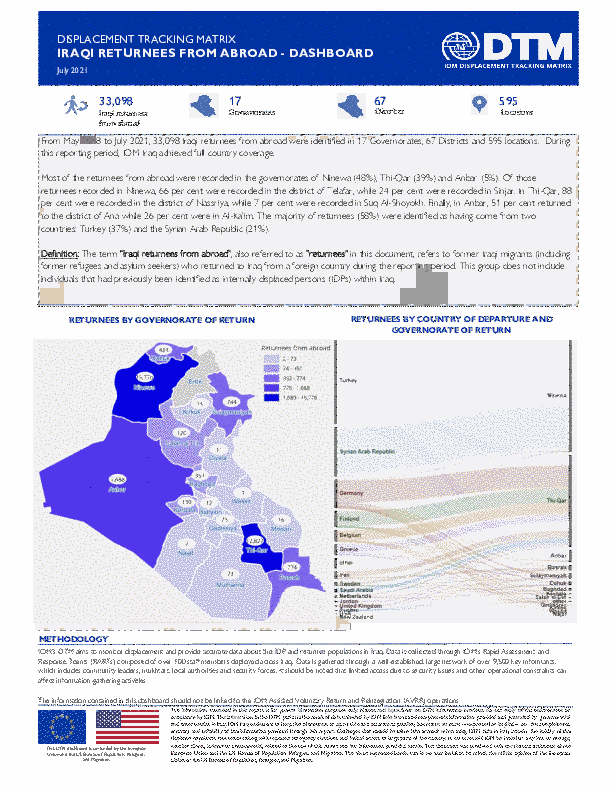
Contact
DTM Iraq, IraqDTM@iom.int
Language
English
Location
Iraq
Period Covered
May 01 2018
Jul 31 2021
Activity
- Mobility Tracking
- Baseline Assessment
From May 2018 to July 2021, 33,098 Iraqi returnees from abroad were identified in 17 Governorates, 67 Districts and 595 locations. During this reporting period, IOM Iraq achieved full country coverage. Most of the returnees from abroad were recorded in the governorates of Ninewa (48%), Thi-Qar (39%) and Anbar (5%). Of those returnees recorded in Ninewa, 66 per cent were recorded in the district of Telafar, while 24 per cent were recorded in Sinjar. In Thi-Qar, 88 per cent were recorded in the district of Nassriya, while 7 per cent were recorded in Suq Al-Shoyokh. Finally, in Anbar, 51 per cent returned to the district of Ana while 26 per cent were in Al-Ka'im. The majority of returnees (58%) were identified as having come from two countries: Turkey (37%) and the Syrian Arab Republic (21%).

Contact
DTM Iraq, IraqDTM@iom.int
Language
English
Location
Iraq
Period Covered
Mar 01 2016
Jun 30 2021
Activity
- Survey
- Community Perception
- Return Intention
- Mobility Tracking
- Baseline Assessment
What happens to households experiencing protracted displacement during a global pandemic? This is not a question that Access to Durable Solutions Among IDPs in Iraq, a panel study conducted by IOM and Georgetown University, initially anticipated answering at its inception six years ago.1 Yet this question is one the study is uniquely positioned to answer. The mixed-method project collects data from surveys and interviews to understand how the same Iraqi IDP households displaced by the conflict with the Islamic State in Iraq and the Levant (ISIL) try to access a “durable solution” to their displacement as defined by the Inter-Agency Standing Committee’s Framework on Durable Solutions. Conducted among the non-camp population of IDPs displaced between 2014 and 2015, the study operationalized the eight criteria that collectively measure a durable solution: safety and security, standard of living, livelihood, housing, access to documentation, family reunification, participation in public affairs, and access to justice. Using each of these criteria over six rounds of data collection, the study has tracked changes in what challenges IDP households face and the solutions they engineer as they search for a durable solution to their displacement. Based on findings from the newest, sixth round of data collection, this report details not only how COVID-19 affects IDPs, but specifically, and in keeping with the purpose of the study, how the COVID-19 pandemic affected IDP households’ abilities to achieve a durable solution. This latter endeavor entails two tasks: first, to identify what challenges persist because they existed pre-COVID-19 (and are thus primarily displacement-related), and second, to identify what challenges the COVID-19 pandemic has created or made worse. The longitudinal nature of the Access to Durable Solutions study and its ability to compare current findings with past trends using the same indicators facilitated disentangling and completing these two tasks

Contact
DTM Iraq, IraqDTM@iom.int
Language
English
Location
Iraq
Period Covered
May 01 2018
Sep 30 2021
Activity
- Mobility Tracking
- Baseline Assessment
From May 2018 to September 2021, 35,307 Iraqi returnees from abroad were identified in 17 Governorates, 69 Districts and 635 locations. During this reporting period, IOM Iraq achieved full country coverage.
Most of the returnees from abroad were recorded in the governorates of Ninewa (45%), Thi-Qar (42%) and Anbar (5%). Of those returnees recorded in Ninewa, 66 per cent were recorded in the district of Telafar, while 24 per cent were recorded in Sinjar. In Thi-Qar, 88 per cent were recorded in the district of Nassriya, while 7 per cent were recorded in Suq Al-Shoyokh. Finally, in Anbar, 51 per cent returned to the district of Ana while 26 per cent were in Al-Ka'im. The majority of returnees (56%) were identified as having come from two countries: Turkey (36%) and the Syrian Arab Republic (20%).
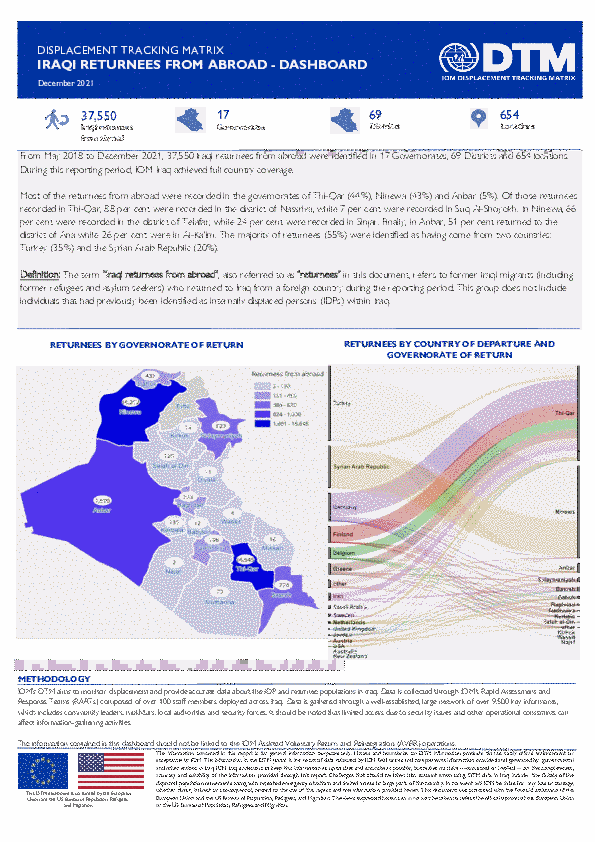
Contact
DTM Iraq, IraqDTM@iom.int
Language
English
Location
Iraq
Period Covered
May 01 2018
Dec 31 2021
Activity
- Mobility Tracking
- Baseline Assessment
From May 2018 to December 2021, 37,550 Iraqi returnees from abroad were identified in 17 Governorates, 69 Districts and 654 locations. During this reporting period, IOM Iraq achieved full country coverage.
Most of the returnees from abroad were recorded in the governorates of Thi-Qar (44%), Ninewa (43%) and Anbar (5%). Of those returnees recorded in Thi-Qar, 88 per cent were recorded in the district of Nassriya, while 7 per cent were recorded in Suq Al-Shoyokh. In Ninewa, 66 per cent were recorded in the district of Telafar, while 24 per cent were recorded in Sinjar. Finally, in Anbar, 51 per cent returned to the district of Ana while 26 per cent were in Al-Ka'im. The majority of returnees (55%) were identified as having come from two countries: Turkey (35%) and the Syrian Arab Republic (20%).

Contact
DTM Iraq, IraqDTM@iom.int
Language
English
Location
Iraq
Period Covered
May 01 2018
Mar 31 2022
Activity
- Mobility Tracking
- Baseline Assessment
From May 2018 to March 2022, 40,332 Iraqi returnees from abroad were identified in 17 Governorates, 69 Districts and 664 locations. During this reporting period, IOM Iraq achieved full country coverage.
Most of the returnees from abroad were recorded in the governorates of Thi-Qar (46%), Ninewa (42%) and Anbar (4%). Of those returnees recorded in Thi-Qar, 88 per cent were recorded in the district of Nassriya, while 7 per cent were recorded in Suq Al-Shoyokh. In Ninewa, 64 per cent were recorded in the district of Telafar, while 22 per cent were recorded in Sinjar. Finally, in Anbar, 51 per cent returned to the district of Ana while 26 per cent were in Al-Ka'im. The majority of returnees (51%) were identified as having come from two countries: Turkey (33%) and the Syrian Arab Republic (18%).

Contact
DTM Iraq, IraqDTM@iom.int
Language
English
Location
Iraq
Period Covered
May 01 2018
Jun 30 2022
Activity
- Mobility Tracking
- Baseline Assessment
From May 2018 to June 2022, 42,713 Iraqi returnees from abroad were identified in 17 Governorates, 73 Districts and 712 locations. During this reporting period, IOM Iraq achieved full country coverage.
Most of the returnees from abroad were recorded in the governorates of Thi-Qar (47%), Ninewa (40%) and Anbar (5%). Of those returnees recorded in Thi-Qar, 88 per cent were recorded in the district of Nassriya, while 7 per cent were recorded in Suq Al-Shoyokh. In Ninewa, 64 per cent were recorded in the district of Telafar, while 22 per cent were recorded in Sinjar. Finally, in Anbar, 43 per cent returned to the district of Ana while 38 per cent were in Al-Ka'im. The majority of returnees (52%) were identified as having come from two countries: Turkey (32%) and the Syrian Arab Republic (20%).
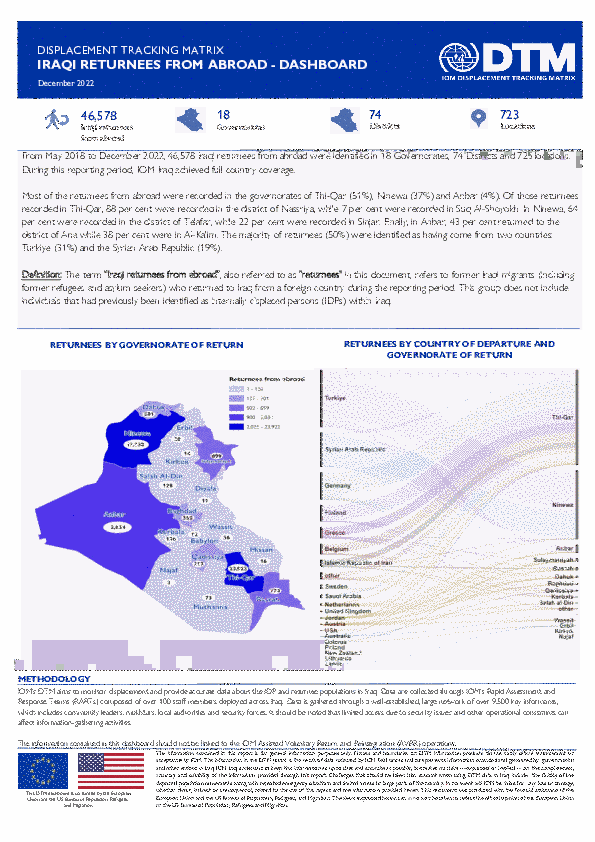
Contact
DTM Iraq, IraqDTM@iom.int
Language
English
Location
Iraq
Period Covered
May 01 2018
Dec 31 2022
Activity
- Mobility Tracking
- Baseline Assessment
From May 2018 to December 2022, 46,578 Iraqi returnees from abroad were identified in 18 Governorates, 74 Districts and 723 locations. During this reporting period, IOM Iraq achieved full country coverage.
Most of the returnees from abroad were recorded in the governorates of Thi-Qar (51%), Ninewa (37%) and Anbar (4%). Of those returnees recorded in Thi-Qar, 88 per cent were recorded in the district of Nassriya, while 7 per cent were recorded in Suq Al-Shoyokh. In Ninewa, 64 per cent were recorded in the district of Telafar, while 22 per cent were recorded in Sinjar. Finally, in Anbar, 43 per cent returned to the district of Ana while 38 per cent were in Al-Ka'im. The majority of returnees (50%) were identified as having come from two countries: Turkiye (31%) and the Syrian Arab Republic (19%).
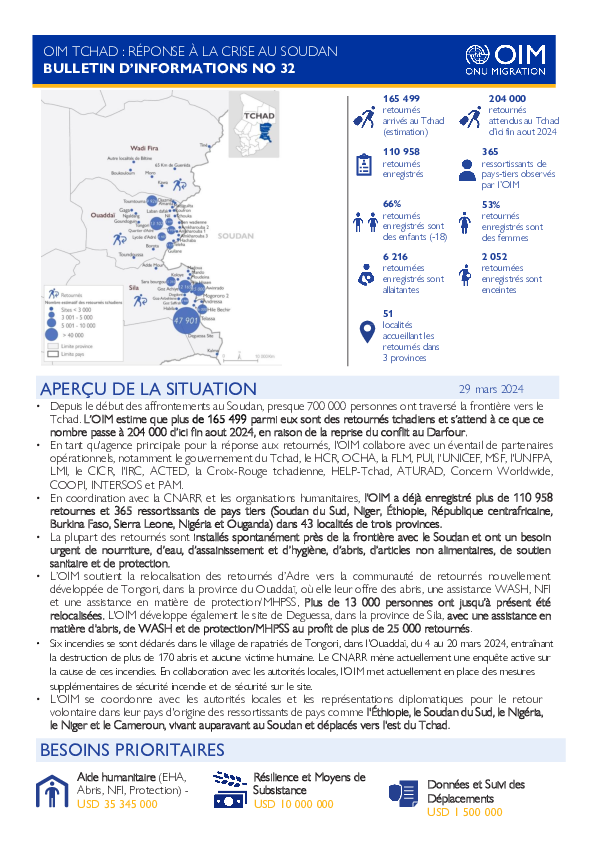
Contact
DTM Iraq, IraqDTM@iom.int
Language
English
Location
Iraq
Period Covered
May 01 2018
Apr 30 2023
Activity
- Mobility Tracking
- Baseline Assessment
From May 2018 to April 2023, 48,536 Iraqi returnees from abroad were identified in 18 Governorates, 74 Districts and 726 locations. During this reporting period, IOM Iraq achieved full country coverage. Most of the returnees from abroad were recorded in the governorates of Thi-Qar (53%), Ninewa (36%) and Anbar (4%). Of those returnees recorded in Thi-Qar, 88 per cent were recorded in the district of Nassriya, while 7 per cent were recorded in Suq Al-Shoyokh. In Ninewa, 64 per cent were recorded in the district of Telafar, while 22 per cent were recorded in Sinjar. Finally, in Anbar, 42 per cent returned to the district of Ana while 38 per cent were in Al-Ka'im. The majority of returnees (48%) were identified as having come from two countries: Turkey (30%) and the Syrian Arab Republic (18%).
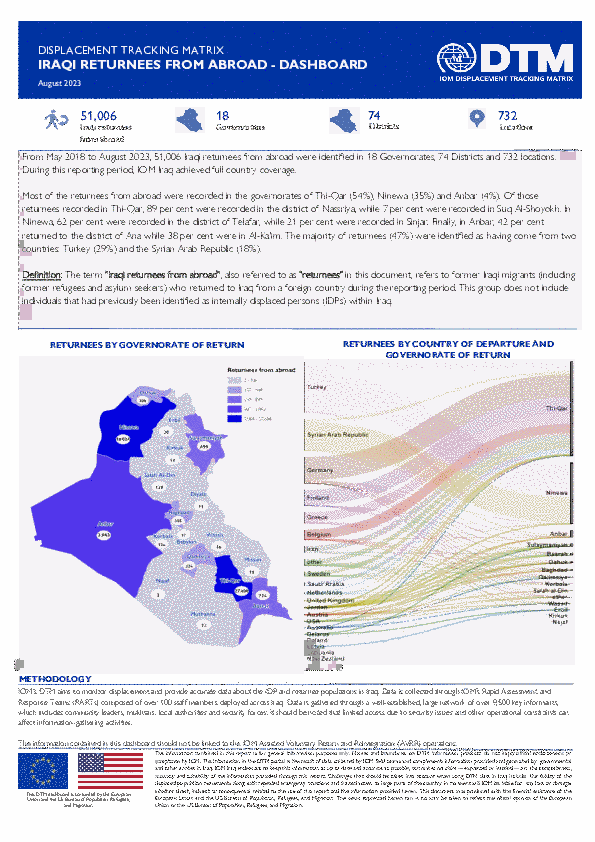
Contact
DTM Iraq, IraqDTM@iom.int
Language
English
Location
Iraq
Period Covered
May 01 2018
Aug 01 2023
Activity
- Mobility Tracking
- Baseline Assessment
From May 2018 to August 2023, 51,006 Iraqi returnees from abroad were identified in 18 Governorates, 74 Districts and 732 locations. During this reporting period, IOM Iraq achieved full country coverage. Most of the returnees from abroad were recorded in the governorates of Thi-Qar (54%), Ninewa (35%) and Anbar (4%). Of those returnees recorded in Thi-Qar, 89 per cent were recorded in the district of Nassriya, while 7 per cent were recorded in Suq Al-Shoyokh. In Ninewa, 62 per cent were recorded in the district of Telafar, while 21 per cent were recorded in Sinjar. Finally, in Anbar, 42 per cent returned to the district of Ana while 38 per cent were in Al-Ka'im. The majority of returnees (47%) were identified as having come from two countries: Turkey (29%) and the Syrian Arab Republic (18%).
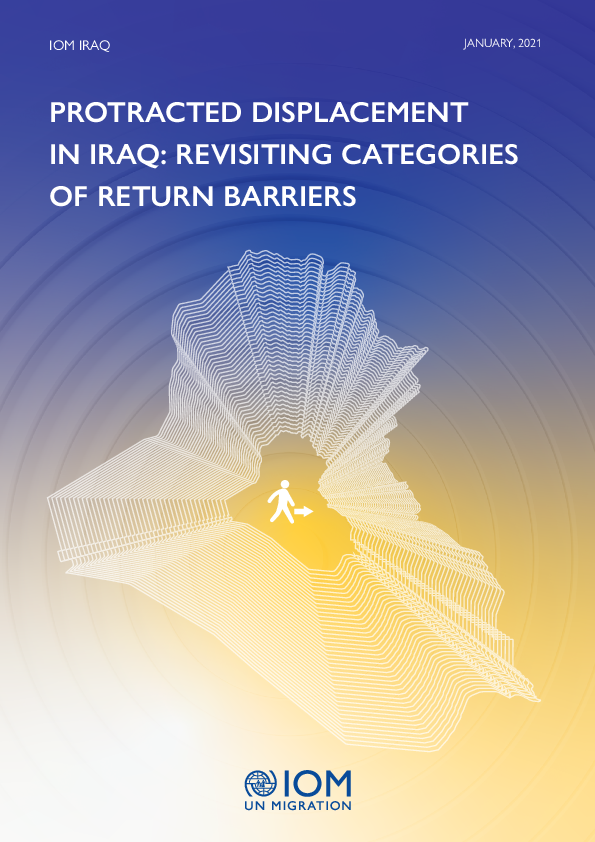
Contact
DTM Iraq, IraqDTM@iom.int
Language
English
Location
Iraq
Snapshot Date
Dec 31 2021
Activity
- Survey
- Return Intention
- Mobility Tracking
- Baseline Assessment
This report, Protracted Displacement in Iraq: Revisiting Categories of Return Barriers, is the second in this series and draws upon new literature and data that has been collected since Categorizing Protracted Displacement in Iraq was published. The aim of this report is to provide an updated evidence base to inform continued strategy development and monitoring relating to the resolution of IDPs in protracted displacement, through: • Providing an updated overview of the current IDP context in Iraq Providing an updated categorization framework and highlighting the different types of barriers faced by IDPs in returning to their areas of origin
Pagination
- Previous page
- Page 31
- Next page
